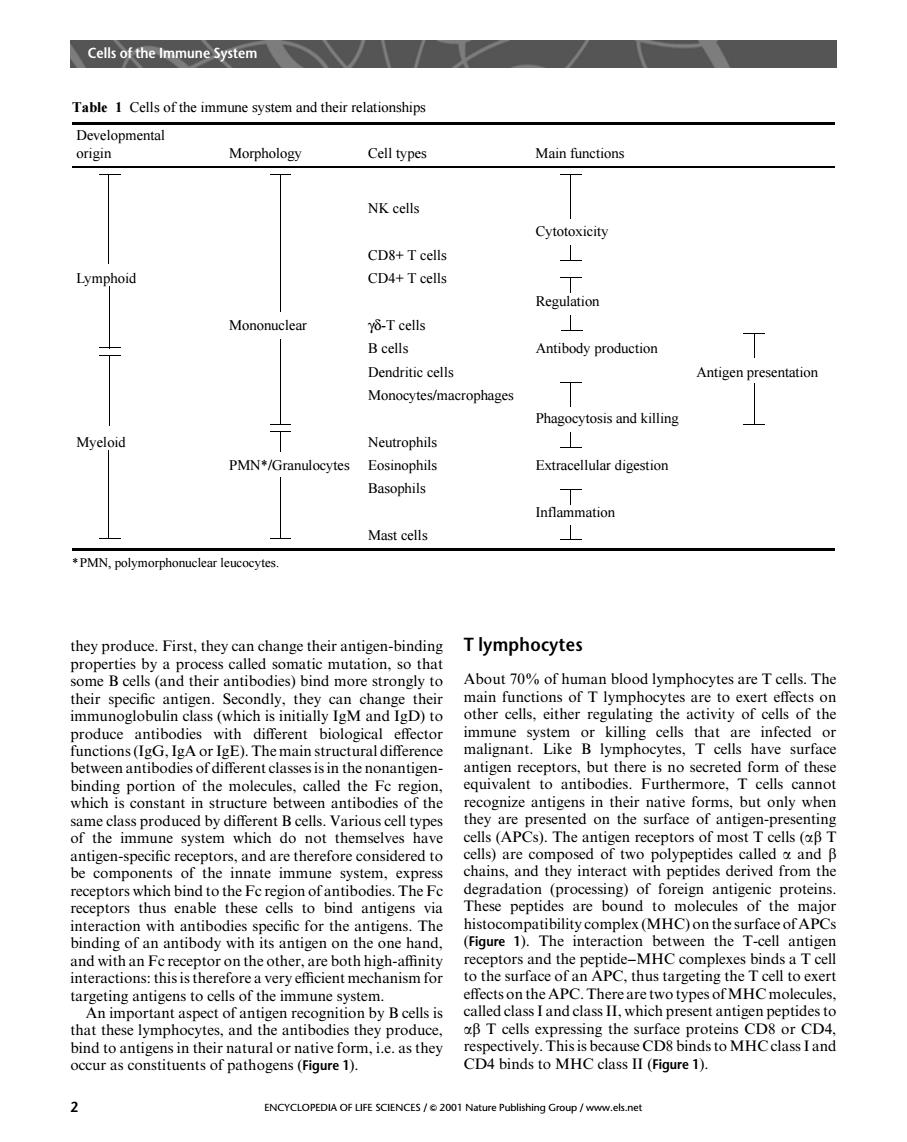正在加载图片...

Cells of the Immune System Table 1 Cells of the immune system and their relationships Developmental origin Morphology Cell types Main functions NK cells Cytotoxicity CD&+T cells ⊥ Lymphoid CD4+Tcells Regulation Mononuclear y-Tcells Bcells Antibody production Dendritic cells Antigen sentation Monocytes/macrophages T Phagocytosis and killing Myeloid Neutrophils PMN*/Granulocytes Eosinophils Extracellular digestion Basophils Mast cells PMN,polymorphonuclear leucocytes. can change their antigen-binding T lymphocytes n ther rties by a pr rocess called somatic mutation.so that D)to immune sy functions(r).The main structuraiference or killing cells that are infected or malignant.Like B lymphocytes,T cells have surface between antibodies of different classes is in the nonantigen- which constant urtne by dimure b they are p f the immune which do not themselves have edon the surface of antige cells(APCs).The antigen receptors of most T cells (aB antigen-specific receptors,and are therefore considered to be compon ents of the expres ey interact rived from ch of fo These pep interaction with antibodies specific for the antig ens The histocompatibility complex(MHC)on the surface of APCs binding of an antibody with its antigen on the one hand, (Figure 1).The interaction between the T-cell antigen plors and a I ce interacti eting the effects on the APC.There are two ty nimportant aspect of antigen recognition by B cells is calldcIand cwhicr peptidesto that these lymphocytes,and the antibodies they produce. natural or native form.i.e.as they 2 ENCYCLOPEDIA OF LIFE SCIENCES/2001 Nature Publishing Group/www.els.net they produce. First, they can change their antigen-binding properties by a process called somatic mutation, so that some B cells (and their antibodies) bind more strongly to their specific antigen. Secondly, they can change their immunoglobulin class (which is initially IgM and IgD) to produce antibodies with different biological effector functions (IgG, IgA or IgE). The main structural difference between antibodies of different classes is in the nonantigenbinding portion of the molecules, called the Fc region, which is constant in structure between antibodies of the same class produced by different B cells. Various cell types of the immune system which do not themselves have antigen-specific receptors, and are therefore considered to be components of the innate immune system, express receptors which bind to the Fc region of antibodies. The Fc receptors thus enable these cells to bind antigens via interaction with antibodies specific for the antigens. The binding of an antibody with its antigen on the one hand, and with an Fc receptor on the other, are both high-affinity interactions: this is therefore a very efficient mechanism for targeting antigens to cells of the immune system. An important aspect of antigen recognition by B cells is that these lymphocytes, and the antibodies they produce, bind to antigens in their natural or native form, i.e. as they occur as constituents of pathogens (Figure 1). T lymphocytes About 70% of human blood lymphocytes are T cells. The main functions of T lymphocytes are to exert effects on other cells, either regulating the activity of cells of the immune system or killing cells that are infected or malignant. Like B lymphocytes, T cells have surface antigen receptors, but there is no secreted form of these equivalent to antibodies. Furthermore, T cells cannot recognize antigens in their native forms, but only when they are presented on the surface of antigen-presenting cells (APCs). The antigen receptors of most T cells (ab T cells) are composed of two polypeptides called a and b chains, and they interact with peptides derived from the degradation (processing) of foreign antigenic proteins. These peptides are bound to molecules of the major histocompatibility complex (MHC) on the surface of APCs (Figure 1). The interaction between the T-cell antigen receptors and the peptide–MHC complexes binds a T cell to the surface of an APC, thus targeting the T cell to exert effects on the APC. There are two types ofMHC molecules, called class I and class II, which present antigen peptides to ab T cells expressing the surface proteins CD8 or CD4, respectively. This is because CD8 binds to MHC class I and CD4 binds to MHC class II (Figure 1). Table 1 Cells of the immune system and their relationships *PMN, polymorphonuclear leucocytes. Developmental origin Morphology Cell types Main functions NK cells Cytotoxicity CD8+ T cells Lymphoid CD4+ T cells Regulation Mononuclear γδ-T cells B cells Antibody production Dendritic cells Antigen presentation Monocytes/macrophages Phagocytosis and killing Myeloid Neutrophils PMN*/Granulocytes Eosinophils Extracellular digestion Basophils Inflammation Mast cells Cells of the Immune System 2 ENCYCLOPEDIA OF LIFE SCIENCES / & 2001 Nature Publishing Group / www.els.net